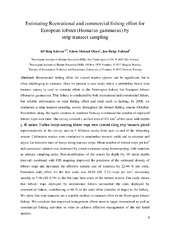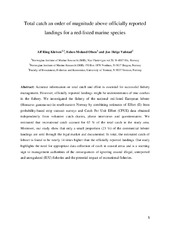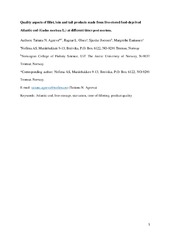| dc.contributor.advisor | Jentoft, Svein | |
| dc.contributor.author | Kleiven, Alf Ring | |
| dc.date.accessioned | 2012-03-30T08:49:28Z | |
| dc.date.available | 2012-03-30T08:49:28Z | |
| dc.date.issued | 2010-09-30 | |
| dc.description.abstract | The implementation of four experimental lobster reserves in Norway in 2006 highlighted a set of important questions regarding lobster management. This thesis presents a study on the management and fishery of the European lobster (Homarus gammarus) in Skagerrak. Firstly, the implementation process of the lobster reserves was analysed. It revealed that local stakeholders, such as recreational fishers, were positive to the use of reserves for management of lobster. However, they were not involved in the implementation process. By reviewing existing literature regarding recreational fisheries, we show that recreational fishers behave differently than commercial fishers. Recreational fishers are not dependent on making profit from the fishery and the value of recreational fishing to those who engage in it is a combination of catch and experience value. The latter implies that recreational fishers can continue fishing when stocks are at a low level, in the same way as subsidised commercial fisheries. We termed this self-subsidising: A fishery as one in which fishers subsidise themselves through an economic investment in gear and time from their non-fishery based earnings. Further, methods to estimate recreational, commercial and total effort and catch were developed. A probability-based strip transect survey method was developed and used to estimate the recreational and commercial effort in the fishery. The survey revealed that recreational fishers outnumber commercial fishers, contributing to 2/3 of the total effort (number of traps) during the season. Lastly, we collaborated with recreational fishers that reported catch and effort through catch diaries. Test validation from a random sample of fishers showed that the catch rate from those who filled out catch diaries could be considered as representative for the recreational lobster fishing population in the study area. We also found that mean recreational catch rates could be considered as representative for the catch rates in the commercial fishery. Our estimates show that recreational fishers represent 65 % of the total landings in the study area. In addition, 77 % of the lobsters caught by commercial fishers remain unreported. Hence, total catch from the recreational and commercial fishery combined, was estimated to be 14 times higher than the officially reported landings. The main conclusion in this thesis is that the lobster fishery can be considered unregulated: there are no quotas, no total effort regulations and no registry of participation from neither commercial nor recreational fisheries. The lack of data information may lead to mismanagement of the lobster fishery with the risk of further population reduction. Further, the positive attitude towards the lobster reserves, as expressed from the local stakeholders, clearly shows the potential in using lobster reserves as an important tool in the management of the European lobster in coastal Skagerrak. Implementation of more lobster reserves should strive to achieve stronger stakeholder involvement from the early start of the process in order to incorporate local user knowledge and ensure legitimacy of new reserves. | en |
| dc.description | Papers 1 and 2 are not available in Munin: <br/>1. Pettersen, A.R., E. Moland, E. Moland Olsen and J.A. Knutsen.: 'Lobster reserves in coastal Skagerrak - An integrated analysis of the implementation process', in E. Dahl, E. Moksness and J. Støttrup (ed), Coastal Zone Management (2009) Pages 178-188. Wiley-Blackwell Publishing. London. <br/>2. Kleiven, A.R., E. Moland and U.R. Sumaila: 'Recreational fishing as a selfsubsidising activity : implications for sustainability of targeted fish stocks' (manuscript) | en |
| dc.identifier.uri | https://hdl.handle.net/10037/4093 | |
| dc.identifier.urn | URN:NBN:no-uit_munin_3813 | |
| dc.language.iso | eng | en |
| dc.publisher | Universitetet i Tromsø | en |
| dc.publisher | University of Tromsø | en |
| dc.rights.accessRights | openAccess | |
| dc.rights.holder | Copyright 2010 The Author(s) | |
| dc.rights.uri | https://creativecommons.org/licenses/by-nc-sa/3.0 | en_US |
| dc.rights | Attribution-NonCommercial-ShareAlike 3.0 Unported (CC BY-NC-SA 3.0) | en_US |
| dc.subject | lobster | en |
| dc.subject | recreational fishing | en |
| dc.subject | Skagerrak | en |
| dc.subject | IUU | en |
| dc.subject | lobster management | en |
| dc.subject | marine reserve | en |
| dc.subject | MPA | en |
| dc.subject | Homarus gammarus | en |
| dc.subject | hummer | en |
| dc.subject | fritidsfiske | en |
| dc.subject | UUU | en |
| dc.subject | UUU-fiske | en |
| dc.subject | hummerforvaltning | en |
| dc.subject | marine reservater | en |
| dc.subject | marine bevaringsområder | en |
| dc.subject | VDP::Agriculture and fishery disciplines: 900::Fisheries science: 920::Resource biology: 921 | en |
| dc.subject | VDP::Landbruks- og Fiskerifag: 900::Fiskerifag: 920::Ressursbiologi: 921 | en |
| dc.subject | VDP::Agriculture and fishery disciplines: 900::Fisheries science: 920::Catch: 925 | en |
| dc.subject | VDP::Landbruks- og Fiskerifag: 900::Fiskerifag: 920::Fangst: 925 | en |
| dc.subject | VDP::Agriculture and fishery disciplines: 900::Fisheries science: 920::Other fisheries disciplines: 929 | en |
| dc.subject | VDP::Landbruks- og Fiskerifag: 900::Fiskerifag: 920::Andre fiskerifag: 929 | en |
| dc.title | The management of lobster in coastal Skagerrak : recreational fisheries, unreported commercial catches andmarine protected areas | en |
| dc.type | Doctoral thesis | en |
| dc.type | Doktorgradsavhandling | en |


 English
English norsk
norsk





